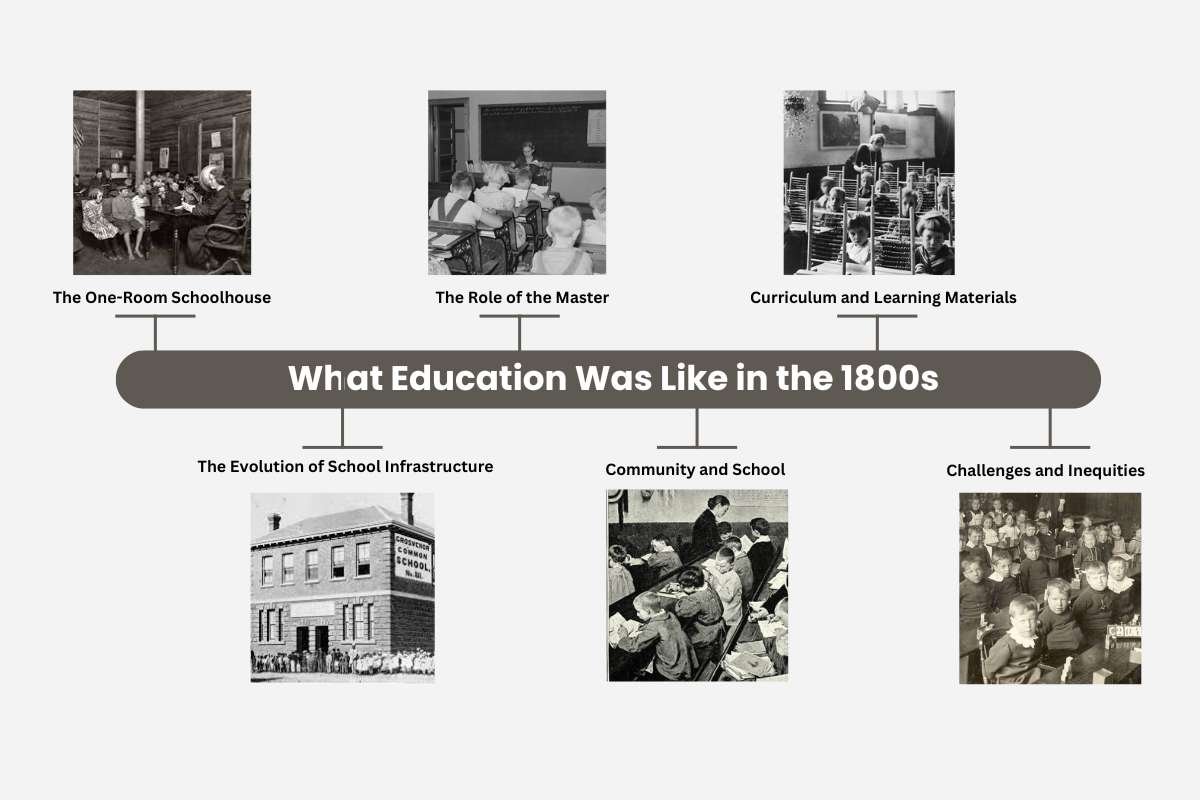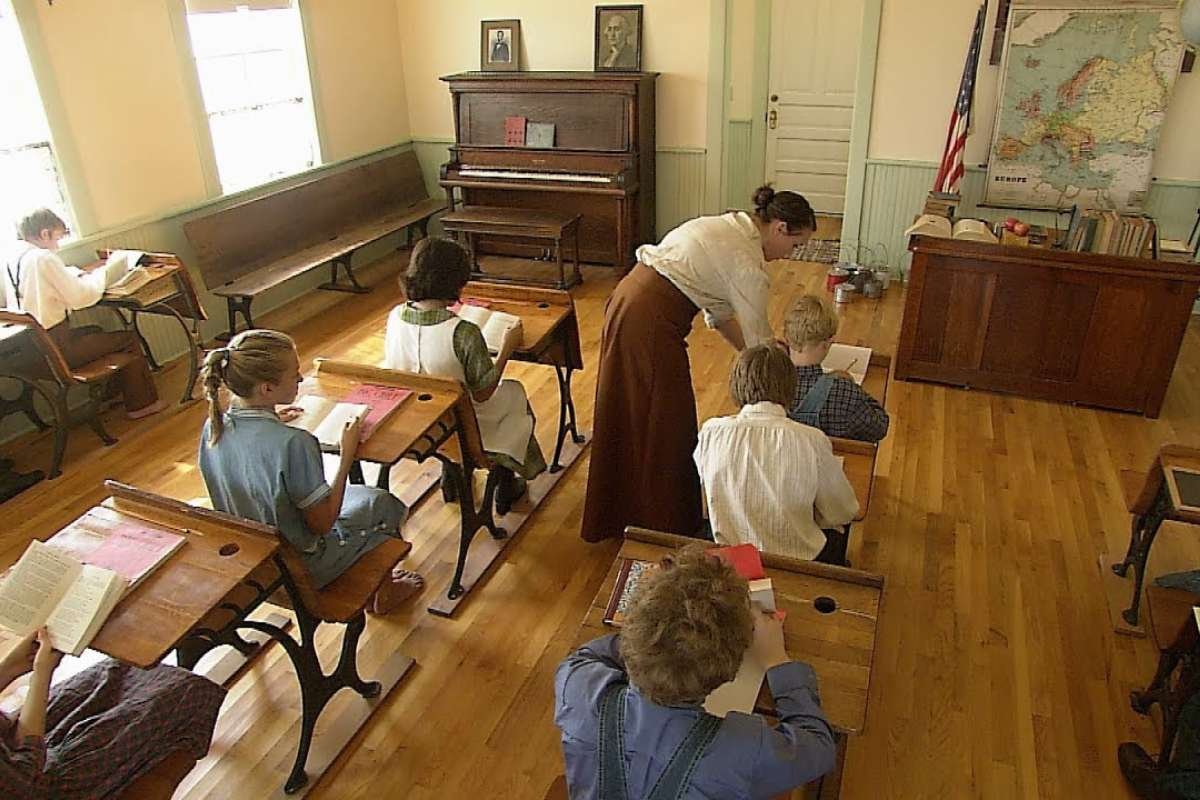I love the aesthetic scenery associated with Western culture. Spaghetti Westerns like The Good, The Bad, and The Ugly and Django Unchained are the perfect examples. It makes me wonder how life would be in such an era. In a rough-and-tumble world of the 1800s where bounty hunters are searching for their bounties, dusty roads rise with a clatter as the horses trot, and rustic landscapes surround the warm breezy towns.
Living in the rustic countryside is lovely, but what’s more exciting is the education in such an era. What is Education was like in the 1800s? This question makes me more curious about how literacy was. A one-room schoolhouse, where kids of all ages sat together with ink-stained fingers gripping slates instead of notebooks. No tablets, no internet, and no network. Teachers are like gunslingers with rulers and armed with chalk on the run to ensure discipline.
Education like in the 1800s was a far cry from today’s high-tech classrooms, yet it had a significant impact and was the core of the modern schooling system. Ever wondered how the students learned? Wait, what about the subjects? It’s time that we find out. Let’s hop on our horses and take a stroll to find out what education was like in the 19th century.
The One-Room Schoolhouse
It was a one-room schoolhouse in a modest wooden building, the heart of rural communities, where the classes were held. A single master educated students ranging from six to sixteen. These schoolhouses were emblematic of what Education was like in the 1800s and served as the primary educational institutions, especially in rural areas. Inside, the classrooms were occupied by diverse students with different abilities. This was a beautiful yet unique learning environment where older students assisted the younger ones, polishing their own knowledge in the process. The school day typically began around 9 a.m. and concluded at 2 or 4 p.m., depending on the region.
There goes the bell! An hour-long break, known as nooning. Students are allowed time for lunch and rest during this period. Attendance, however, was not consistent. In 1869, student attendance averaged about 59%, with many children absent due to illnesses or obligations at home, such as assisting with farm work.
The Role of the Master

In the early 1800s, teaching was predominantly a male profession. Men often used teaching as a stepping stone to careers in law or the clergy. However, by the 1840s, women began to enter the teaching workforce in significant numbers, responding to the growing demand for educators. By the early 1900s, women constituted the majority of teachers in the United States. Teachers were revered authority figures, responsible not only for imparting knowledge but also for maintaining discipline. Classroom management was strict, with corporal punishment commonly employed to correct misbehavior. Students might face physical reprimands or be assigned menial tasks as a consequence of their actions. This rigid discipline was believed to instill moral character and respect for authority.
Curriculum and Learning Materials
So, what the curriculum of Education was like in the 1800s? The curriculum of the 1800s was centered around the Three Rs, i.e., Reading, Writing, and Arithmetic. These foundational subjects were deemed essential for all students. Reading materials often included the Bible, fables, and moral stories. The main aim was to instill ethical values blending with literacy. Writing focused on penmanship, with students practicing their handwriting using quills and ink.
Arithmetic lessons emphasized practical applications, such as measurements and basic calculations. School supplies were minimalistic. Students used slates and chalk for writing, as paper was a luxury. Books were scarce, and when available, they were shared among students. A culture of memorization and oral recitation was instilled due to this scarcity with students often learning and repeating lessons to demonstrate understanding.
The Evolution of School Infrastructure

When talking about what education was like in the 1800s, the thought of what the infrastructure could have been always struck. Early 1800s schoolhouses were often simple log or wooden structures This used to reflect the limited resources of rural communities. All the buildings had no modern amenities, relying on wood-burning stoves for heat and natural daylight for lighting. Students were sometimes required to bring logs to school to contribute to the heating during colder months.
As the century progressed and communities grew, there was a shift towards constructing more substantial brick-and-mortar school buildings. These new structures often included multiple rooms, allowing for some separation of students by age or subject matter, laying the groundwork for the graded school systems we recognize today.
Read More: Dodge Your Financial Constraints: Top 7 Countries Offering Free Education for International Students
Community and School
Schools in the 1800s often served as communal hubs. Beyond their educational purpose, they hosted town meetings, community events, and social gatherings. Education like in the 1800s was not just about academic learning. It was deeply philosophical about livelihood. Parents played an active role in supporting schools, sometimes donating firewood, and books, or even helping build the schoolhouses themselves.
Teachers, too, were integral community figures, often boarding with local families in exchange for their services. In many rural areas, schooling was seasonal. Children attended during winter and early spring when farm work was minimal, but during planting and harvest seasons, they were often needed at home. This made education a privilege rather than a guaranteed right, and many children never completed their schooling beyond the basics.
Challenges and Inequities
Education like in the 1800s was not uniformly accessible. Socioeconomic status, race, and gender significantly influence one’s educational opportunities. In many Southern states before the Civil War, laws prohibited the education of enslaved African Americans. Even in the North, Black children faced substantial obstacles in accessing quality education. After the Civil War, efforts were made to establish schools for Black students, but segregation and resource disparities persisted for decades.
Gender also played a pivotal role in educational experiences. While boys and girls might attend the same schools, their curricula often differ. Girls were typically taught subjects like sewing and etiquette, preparing them for domestic roles, whereas boys received instruction in subjects deemed more rigorous, such as advanced mathematics and sciences.
The Impact of 19th-Century Education
Thinking about what education was like in the 1800s brings a sense of melancholy, softened by the warmth and cheers of kindhearted people Despite its challenges, education like in the 1800s laid the foundation for modern schooling. The one-room schoolhouse, the discipline-driven teaching style, and the emphasis on literacy and numeracy impacted how future generations learned.
Many of the practices from this time, such as memorization, recitation, and the importance of moral education, are still being followed. As the century ended and the Industrial Revolution surged forward, education systems became more structured. Public schooling expanded, teacher training improved, and reforms sought to make education more accessible to all, regardless of background. This transformation set the stage for the standardized schooling system we know today.
Also Read: The Future of Education Technology: Transforming Learning for the 21st Century
The Closing Bell
Now that the stroll has ended, the time is here to ring the closing bell. So what education was like in the 1800s? A blend of simplicity and discipline, influencing bright minds with chalk and a firm hand. Though today’s classrooms are filled with technology and endless resources, the foundations of learning were built in those one-room schoolhouses. So next time you pick up a tablet or turn on a smartboard, remember the students who once scratched their lessons onto slates, recited verses aloud and learned under the watchful eye of a stern schoolmaster. Education has evolved but the roots remain the same.
What Education Was Like in the 1800s

- 📚 The One-Room Schoolhouse – A single teacher taught students of all ages in small wooden schoolhouses.
- 👩🏫 The Role of the Master – Teachers were strict disciplinarians, often using corporal punishment.
- 📖 Curriculum and Learning Materials – Learning focused on reading, writing, arithmetic, and moral lessons.
- 🏫 The Evolution of School Infrastructure – Schools evolved from simple log cabins to brick buildings with multiple rooms.
- 🌍 Community and School – Schools doubled as community centers for meetings and social events.
- ⚖️ Challenges and Inequities – Education access varied by race, gender, and socioeconomic status.










